

On 26 August 1942, Mrs. Maurice J. Tobin, wife of the Honorable Maurice J. Tobin, Governor of the Commonwealth of Massachusetts, sponsored the launching, and on June 30 1943, the ship's ensign fluttered in a gentle breeze as she was officially commissioned and accepted by her first commanding officer, Captain John H Carson, USN.
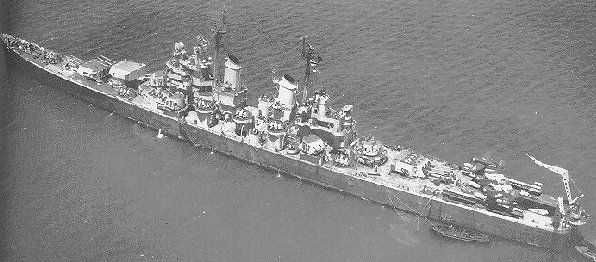
USS BOSTON (CA-69)
Slipping smoothly through Atlantic waters, the Boston began her maiden voyage and on August 13 1943 was in route to the Gulf of Paria, between Trinidad and Venezuela, for the shakedown cruise designed to accustom her crew to the sea and enable officers to detect any possible wrinkles in her makeup. A month later the BOSTON returned to her home port, a fighting ship with her crew well trained to fight the enemy. On the record of her engineering trials, she was established as one of the fastest heavy ships in the fleet, on the record of her gunnery exercises she was established as a good gunnery ship. She mounted nine 8 inch/55 caliber guns in three turrets, twelve 5 inch/38 caliber dual purpose guns in 6 mounts and a host of 20mm and 40mm antiaircraft guns. She had a standard displacement of 13,600 tons, an overall length of 673 feet, 5 inches., and a beam of 69 feet, 9 inches.
After a few more weeks in the port of Boston and some trial runs off Rockland, Maine, the USS BOSTON set out on November 18, 1943 to fulfill the job for which she was designed and built --- the defeat of this country's enemy in the Pacific. After passing through the Panama Canal, BOSTON had a two day lay-over in San Francisco. Another LTJG and I signed up for a hotel room at the Fairmont Hotel, so that we could sleep-in in the morning. On our shore leave liberty, we met some of our Officer Shipmates who did not have hotel reservations, so of course we invited them to share our room. When we awoke in the morning, there were six cots filled with Junior Officers, and of course two beds for Tom and me. The add-ons paid for the beds of RMH and TOM in addition to their own cots!
RMH and crew in the Boston's First
Division (from the Boston's WWII cruisebook)
The BOSTON arrived at Pearl Harbor on December 6, 1943 on the eve of the second anniversary of the Japanese sneak attack. Six weeks were spent in Pearl Harbor waters engaging in special exercises and training. It was here that I met up with my brother Ken for the first time in six years. He was air officer on the NASSAU, a jeep carrier that was used to ferry combat planes to where the big carriers were in the western Pacific. He invited me to come aboard for lunch and to show me around his ship. He had some pictures taken of us together which I ultimately got a copy of through my copy of the GRACEVILLE ENTERPRISE. The article stated "Hanson Brothers Meet In The Far Reaches Of The Pacific After Six Years". Dad was so proud of his two sons that he wanted every one in Graceville to know about our meeting.
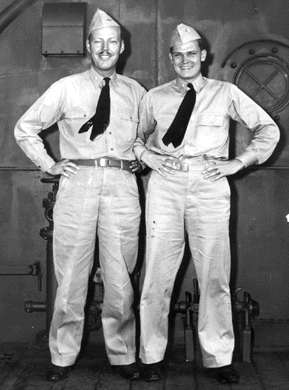
The Hanson brothers meet again
Ken advised me that heat rash was a problem in the South Pacific, as the only ship spaces that were air conditioned were electronic areas which needed the cooling to remain operational. I sailed from Pearl Harbor with a full case of Ammens Medicated Powder and used it all in our first trip to the South Seas in the BOSTON (although more than half of it was used by fellow officers who had not brought any). I had Ken come aboard the BOSTON to show him the ins and outs of MY ship, which of course was larger, had more armor, armament, speed, radar and firepower.
Swede and Ken on the BOSTON
All hands manned their battle stations on January 19, 1944 as the BOSTON got underway from Pearl Harbor and began her long war career as a unit of the soon-to-be famous Task Force 58. Planes from the old SARATOGA, the later-to-be-sunk PRINCETON and the LANGLEY soared overhead on antisubmarine patrol. On February 2, 1944 planes from the SARATOGA bombed a direction finding station on Utirik Atoll and as the smoke from their hits floated skyward men on the BOSTON knew that "this was it".
During the following five days the carrier planes struck Eniwetok Atoll while the BOSTON kept a wary eye out for Japanese planes and subs. Covering the seizure of the Marshalls she roamed between Wotje and Eniwetok. After Kwajalein was secured the BOSTON anchored in Roi Harbor for three days and then returned to Eniwetok where for 18 days she circled the atoll with the rest of the force, prepared to lend fire support to the Marines ashore who fought to secure the base which was to become so vital in the prosecution of the war. When Eniwetok was secured the task group put in at Majuro, and the BOSTON's crew got its first taste of "liberty" in the far Pacific. Early in March BOSTON left Majuro for Espiritu Santo in the New Hebrides.
From there the BOSTON sailed north once more to rejoin Task Force 58 in the first raid on the Palaus and the Western Carolines. Radarmen aboard were kept busy detecting enemy planes, and late in the afternoon of March 30 the carrier CABOT reported that her fighters had shot down all enemy planes in a formation of seven. At dusk Japanese torpedo planes attacked the task force and for the first time the guns of the BOSTON fired at the enemy. Later a Japanese pilot was picked up by a ship of our group, and his story indicated that his plane was the BOSTON's first victim. It was in this area also that planes from the BOSTON rescued an officer pilot and two enlisted men from a plane that crashed during one of our carrier strikes. On the return trip to Majuro, raids were also made at Woleai and Yap. The Japs, having felt the sting of the task force, were leaving it strictly alone and no trouble was experienced.
On April 22, 1944, the BOSTON once more sortied from Majuro with the Task Force to support General MacArthur's Southwest Pacific Forces in the seizure and occupation of Hollandia in New Guinea. One week later, on the way back from Hollandia the task force journeyed slightly afield to deliver a sharp crack at the Japanese fortress of Truk. Suddenly an enemy plane was sighted off the BOSTON's starboard bow and the BOSTON's guns opened fire. In the subsequent action, which has been recorded in technicolor for the movie "Fighting Lady," the BOSTON scored her first definite kill, shooting down the attacking "JILL".
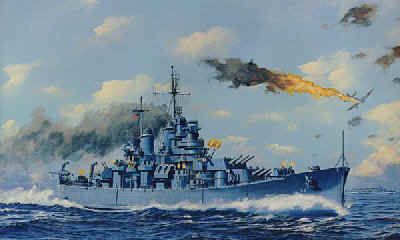
April 1944: USS Boston shoots down
attacking Japanese torpedo bomber
Formed up once more with Task Force 58, the BOSTON headed for Guam with a new Commanding Officer at the helm - Captain E. E. Herrmann, USN, of Washington, D.C. - who boarded the ship on June 5 1944 and was destined to carry it safely through many missions against the enemy. Guam was the first stop on what was to be one of the longest cruises of her career, and also one of the most vital missions of the entire war --- the attack on the Marianas. When it had been completed, we had secured operating bases for our B-29s, had nearly snipped in two the Japan life line to the south, and had almost annihilated Japan's carrier air power.
As the force approached Guam, a Japanese plane, spotting the mighty ships, radioed a warning; but our fighter planes making a sweep over the island never-the-less took the enemy by surprise by our departure from our usual procedure of striking at dawn. The results were very successful. Speeding northward, the group then struck swiftly at Iwo Jima and headed southwest again with orders to launch a long range search for the Japanese fleet, reported as passing through the San Bernardino Straits. Their obvious intent was to bolster the defense of the Marianas.
At ten o’clock on the morning of June 19, 1944 began what was known as The Marianas Turkey Shoot. Certainly the first day's action was dramatic and extremely successful. At the end of two days fighting (19th and 20th June 1944) the Japanese had lost all but 35 of their original 430 planes. However, as far as we black shoes were concerned, the excitement of the first day was mostly out of our sight, and we, in my particular group, saw little of the shoot. The combat air patrols of Task Force 58 and others of our planes kept the enemy away from our Task Force so there were relatively few chances for action on the part of the ships.
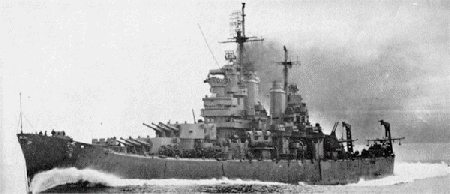
The second day of the engagement was spent in hunting for the Jap fleet and it wasn’t until relatively late in the day, about 1600, that it was spotted. The distance was estimated at 250 miles and was at the extreme range of our planes. The strike, if sent out, would be forced to return after dark with all the attendant problems and likely high losses of planes and personnel. Admiral Mitscher sent off the first full deck loads of planes at 1621, but by the time the second deck loads were spotted, a better position report on the Jap fleet, put it at 275 miles so the second flight was not launched.
The force we sent out consisted of 85 fighters, 77 dive bombers, and 54 torpedo bombers from six big carriers and five light carriers. They sighted the Jap fleet at 1840 after some 275 to 300 miles of flight and the sun was just setting. The strike was successful and completed the destruction of the Japanese aircraft as well as sinking and damaging the ships of their fleet. The first of our returning planes began circling the carriers at 2045, a full half hour after full darkness had set in. Admiral Mitscher had given orders to light up the carriers to help our returning pilots.
I was Officer Of The Deck on the BOSTON during the recovery operation. News of the successful attack spread throughout the fleet and plans were made to recover the returning planes --- most of them were running out of fuel as they reached the task force, and most of them came in at the same time. There was no way, even under the best of conditions that they all could be recovered by the carriers. We had some 200 planes in the air and it was a major feat that about three quarters of the planes were able to land on a carrier. That left about 50 planes to land in the water. As the planes approached visual range of the task force, we began to "light ship" --- we first turned on our running lights (and carriers turned on their recessed lights in the flight deck). Then on instructions from the Flag, we turned on topside lighting. Next the DDs (destroyers) turned on their searchlights. Remember that none of us had seen ships lighted like this since well before start of the war. The destroyers even fired starshells to help guide the pilots back for a landing.
We were still in formation with the screen DDs on the perimeter as was usual --- probably 30 destroyers surrounding each of the four Task Groups with the larger ships ranging in from the screen and the carriers in the center of the formation. By the time the carriers began to recover returning aircraft, the whole ocean was lit up like Times Square!!! I am sure that the carrier people have stories to tell of the landing that would fill a book but I can only report on what happened in the vicinity of the BOSTON.
The news of the successful attack had spread through out the task force. All hands were now involved in trying to save all our pilots. Of course we had turned into the wind for plane recovery and we stayed on course throughout the "recovery" operation --- no zig zag. If there were any enemy subs around they could have had a field day, but there weren't and they didn't.
Planes that couldn't get into line for carrier recovery had to land in the ocean. The procedure was to fly parallel to and close aboard one of the larger ships and to "wiggle" his wings as he flew by, indicating that he planned to land close aboard that particular ship. We in the BOSTON had four such "recoveries". When we saw a plane make such an approach (and they were at deck height when they made their "signal" pass) we would turn on one of our main search lights down into the water several hundred feet abeam and ahead to give the plane a "spot" to land. The search light beam on the water not only gave the plane's pilot a landing location, but it also alerted the screen destroyers to the fact that a plane was about to land. The designated destroyer would head for the searchlight spot to meet the landing plane. Talk about ship handling!!! Remember that the entire force was doing 20 knots into the wind on steady course. The destroyers maneuvered through the entire formation picking up plane crews as they went. After a plane made its first pass indicating that it had to land in the water, we put our searchlight on the landing spot and the plane then circled us and landed on the second pass --- trying for the searchlight spot. The destroyer assigned would come up astern of us (probably doing at least 30 knots, and on several occasions was able to stop alongside just as the plane landed. I saw several crew members picked up from the plane wing literally without getting their feet wet! As soon as the plane crew was aboard, the destroyer would go to full power (you could hear her forced draft blowers scream!) and, in most cases, the destroyer would pull ahead of the cruiser and cross her bow on the way to the next pick up. In some cases pickups were made in the time that it took BOSTON to pass the ditched plane. The destroyer engineering force must have had their hair on end for the half hour or so that the rescue efforts took --- ahead full to 30 knots, to back full, stop, then ahead full again. Relief valves were popping, blowers howling, wakes like you wouldn't believe. More than 50 planes ditched and we lost three men in the recovery operation. Unbelievable!!!!
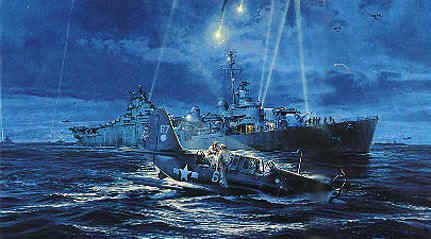
June 20th, 1944: A
ditched dive bomber's crew about to be picked up by a destroyer
This was the first of seven major raids during the day, numbering from one to 90 planes. The most significant fact of the action was the complete annihilation of enemy planes. The following day searches for the Jap Fleet were continued, and late in the afternoon one of our airmen radioed that he had sighted the enemy task force 215 miles to the west. The BOSTON increased her speed, hoping for a surface battle. Again our carrier planes struck and badly damaged one Japanese carrier and other units of the enemy's dwindling fleet. The next day the Japanese force was out of range, but the mission was successful, for the enemy had been chased back to his lair, and the amphibious landings of the Marianas continued without interruption.
The Commander of our task force expressed sympathy that our ship's gunners did not get a chance to take a crack at the Japanese Fleet and labeled the enemy "not only yellow in color but in spirit as well." Summation of damage inflicted showed that 402 enemy planes were destroyed in the action which will forever be remembered by airmen as the "Marianas turkey shoot." Damage to the enemy fleet was also revealed to be substantial, including the sinking of one carrier, two destroyers and a tanker, and damage to three carriers, one battleship, two heavy cruisers, one light cruiser, two destroyers and three tankers. Warm congratulations were received from Admiral Nimitz who declared that "your air groups have turned in another splendid job."
Another punch at Iwo Jima was landed on June 24, 1944 and although our planes were outnumbered the odds were quickly shortened. Score for the day: 116 planes shot down to our loss of 5. At the end of June 1944 a rush trip was made by the BOSTON to the new base at Eniwetok for provisioning, and then the ship returned to Iwo Jima to celebrate the Fourth of July by giving that island its first plastering by naval guns. For more than an hour, the BOSTON lobbed in eight and five inch shells, hitting installations and its southern airfield, where almost seventy aircraft were lined up like lambs for the slaughter.
My General Quarters station for this action was in the Main Battery Director (spot one). There was a rock in the water about ten feet square in size located 100 yards offshore on which I continually sent the range and bearings to the main battery computer for the laying of the 5" and 8" guns for bombardment of the island and the air strip. The next day, when our landing force was ashore, they reported that they had captured two Japanese men from "my" rock. "Splendid afternoon's work," radioed the commander of the Task Unit, "smartly carried out by all hands, and understood by the enemy."
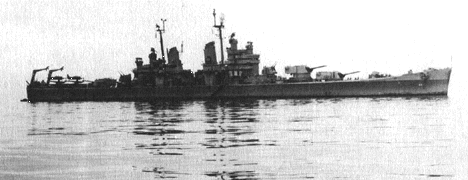
From Iwo, the fleet headed south toward Guam and for two weeks ably fulfilled its assignment of keeping airfields on Guam and Rota neutralized; intercepting and destroying enemy aircraft approaching the Marianas from the south; and destroying enemy installations on Guam.
After the Guam landings were well underway, the fleet struck at Woleai, Palau, Yap and Ulithi. In giving credit to the BOSTON and other ships of the task force, the Marine Commanding general said, "No higher credit can possibly be given to any force than is due to Task Force 58. You keep the enemy off our necks."
The first of September 1944 found the BOSTON proceeding out of Eniwetok with the newly formed Third Fleet under Admiral Halsey, on a mission which was to result in shortening the war perhaps by months. Strong fighter sweeps against Palau were launched on September 6, 1944, but were reduced to half on the following two days for airmen reported that they were running out of targets. In rapid succession, Mindanao, Cebu and the Negros Islands were hit. Over the last two named islands 35 enemy planes were shot down, 34 destroyed on the ground and 47 damaged. Zomboanga was next on the list, and then the BOSTON headed for Morotai to support landings there while others of the fleet backed the landings at Peleliu and the peaceful occupation of Ulithi.
On September 19, 1944, Clark and Nichols Field and shipping in Manila Bay were hit. All hands were feeling a quiet exhilaration and seconded the commendation of the Task Force Commander who said, "They cannot stop you."
(End of story)
LIST OF USS BOSTON OPERATIONS FOR 1944 (list by RMH)
Participated in the Marshall Islands Campaign.
Participated in the capture and occupation of ENIWETOK.
Participated in attacks against PALAU and WESTERN CAROLINE ISLANDS.
Participated in the attach and occupation of HOLLANDIA and NORTHWESTERN NEW
GUINEA, and subsequent attacks on TRUK and the bombardment of SATAWAN ISLAND.
Participated in the attack on the MARCUS ISLANDS and the attack on WAKE ISLAND.
Participated in the attacks on GUAM and ROTA ISLANDS (Marianas Group) on 11-13
June, and the attacks on IWO JIMA, CHICHI JIMA, and HAHA JIMA (Bonins) on 15-16
June 1944.
Participated in the engagement and defeat, by Task Force 58, of a major Japanese
force in the waters west of the Marianas Islands during the period 17-21 June
1944.
Participated in the attacks on PAGAN ISLAND (Marianas Group) and IWO JIMA (Bonin
Islands Group) on 23-24 June 1944.
Participated in bombardment of IWO JIMA on 4 July 1944.
Participated in the attacks on GUAM and ROTA and subsequently in operations in
support of the invasion of GUAM.
Participated in the attacks on PALAU ISLANDS.
Participated in the attacks on MINDANAO and the VISAYAN GROUP (Phillipine
Islands) during the period 9-14 September 1944, subsequently participated in the
attack on CELEBES ISLAND and in the operations in support of the landing on
MOROTAI ISLAND.
Participated in the attacks on LUZON during the period 21-22 September 1944 and
in the attacks on the VISAYAN GROUP (Phillipine Islands) on 24 September 1944.
Participated in the attacks on NANSEI SHOTO ISLANDS on 10 October 1944, and
LUZON on 11 October 1944.
Participated in the attacks on FORMOSA during the period 12-14 October 1944.
Participated in the attacks against a major Japanese task force in the SECOND
BATTLE OF THE PHILLIPINE SEA during the period 25-26 October 1944.
Participated in the attacks on MANILA BAY AREA (LUZON) on 5, 6, 13, 14, and 19
November 1944, and against Japanese shipping in SUBIC BAY and LINGAYEN GULF on
19 November1944.
Participated in the attacks against Japanese shipping in the waters between
LEYTE and CEBU ISLANDS on 11 November 1944.
Participated in the attacks on LUZON during the period 14-16 December 1944.
PORTS VISITED: Pearl Harbor, Espiritu Santo, Majuro, Kwajalein, Eniwetok, Manus, Saipan, Ulithi